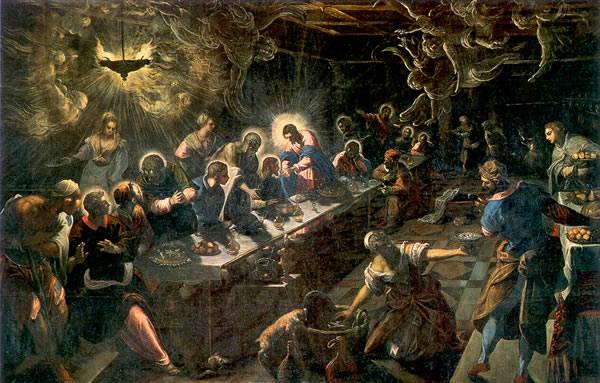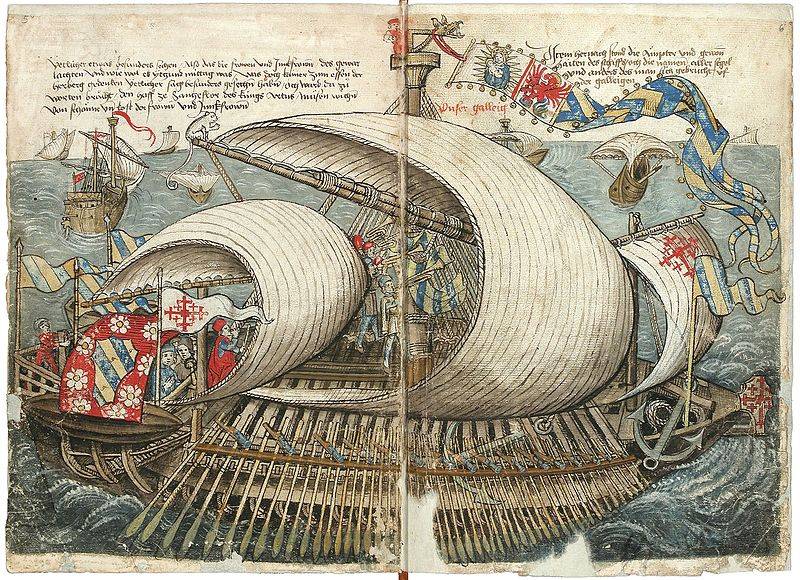The Renaissance and the Decay of the Western World

The Last Supper. Tintoretto
Renaissance
The Renaissance was a turning point for stories Europe: from the Middle Ages to the New Age. On the one hand, it was a time of renaissance, a renaissance of culture and art, based on antiquity. Time of transition to the secular nature of culture, humanism and anthropocentrism. Time of brilliant thinkers, artists, architects. Great geographical discoveries.
On the other hand, this is the era of the most cruel and bloody wars, uprisings, conspiracies and insidious murders. Religious, fratricidal wars. The great geographical discoveries turned into a new wave of violence, cruel colonization, robbery of great and ancient civilizations, cultures, nationalities and tribes of America, Africa and Asia. A surge in piracy and the infamous slave trade. Human and drug trafficking.
The map of then Western Europe was very different from the modern one. Practically each of the current countries was fragmented into many independent feudal estates. There were no modern Italians, Germans and French. These nations were at the stage of formation. The inhabitants of Northern and Southern Italy are still very different from each other, but then they were completely different ethnic communities. In France, the population of Gascony, Brittany or Burgundy had their own languages, history and culture. Various Germans - Saxons, Alsatians, Bavarians or Prussians - did not understand the languages of other Germans.
It is interesting that the Russians-Russians at that time were already an established people-nation, with a developed spiritual and material culture (for example, with developed hygiene, a culture of cleanliness), a single language, faith and traditions. With a developed urban culture, chronicles, which were not in sight in Western Europe. Another daughter of Yaroslav the Wise, Anna Yaroslavna, having become the Queen of France, wrote to her father that she had ended up in a “barbarian country”. The cities of Europe, in comparison with the Russians or the "Tatar" ones (in the Horde), were impoverished and gloomy villages, without signs of culture and art. The French, the British or the Germans at that time were just emerging as nations, when the Russians were building great powers-empires.
Most European countries simply had nothing to develop some kind of culture on such a foundation (political, economic and cultural). In France, in the XNUMXth century, processes of centralization began, but success was still far away. French kings fought with large feudal lords, de facto independent rulers of Burgundy, Brittany, Provence. The wars were extremely brutal. Each other's possessions were completely devastated, the inhabitants of the captured cities were destroyed and stolen.
In England, there was an internecine war of the Scarlet and White Roses of two branches of the Plantagenet dynasty - Lancaster and York. In it, the English feudal lords slaughtered each other so enthusiastically that they almost destroyed their estate, giving the new nobles the opportunity to rise. In Spain, the Christian kingdoms of Castile, Aragon, Valencia, and Navarre fought the remnants of the Muslim Caliphate.
Italy - the center of the Renaissance
Italy became the epicenter of the Renaissance. It also was not united, it was fragmented into a mass of feudal estates. However, there were several important prerequisites that allowed the region to become the epicenter of the Renaissance.
First, here was Rome, as the heir to the first Rome - the cradle of Western civilization, the Western project to enslave the surrounding civilizations, cultures, peoples and tribes. Parasitization and prosperity at the expense of someone else's energy and resources. Catholic Rome was the "command post" of the Western world, the center of the then globalization. Remains of ancient knowledge and science have been preserved here. The church became the base for the expansion of the West to the North, East and South. Then and further to the West - a throw across the Atlantic.
Secondly, Rome, as the ideological organizer of the crusades to the East and South, and other Italian cities, concentrated enormous wealth. In particular, looted in the cities of the Middle East and the dying Byzantine Empire (the second Rome). If the Frankish, English, German and other knights for the most part simply died in a foreign land, playing the role of "cannon fodder", then their income, mortgaged lands, property and looted treasures flowed to Venetian, Genoese, Florentine, Roman merchants, shipowners and usurers (future bankers). Italian moneybags financed military operations, provided sea transportation of troops and supplies.
Thirdly, Italian merchants, city-states monopolized navigation in the Mediterranean. That is, the main trade routes from Asia to Europe and vice versa. First of all, this is a trade in spices, silk and luxury goods. Spices were worth their weight in gold. Without them, with the then technologies, it was impossible to procure meat for the future. And silk clothes were the main protection of the wealthy sections of the population from lice and fleas. After all, there was no culture of cleanliness and hygiene there. European cities literally drowned in mud, human and animal waste. Europeans practically did not wash. And perfume began to be used to drown out the smell of unwashed, dirty bodies.
Therefore, oriental goods were very expensive, giving the Italian intermediary merchants extra profits. We must also not forget that the initial capital was also created on the basis of the most severe exploitation of ordinary people, on outright piracy and the completely legal slave trade at that time. So, Genoa exported people (slaves) from the Crimea, which was part of the Horde state. The wealthy of the city and the merchants. The families of major bankers Medici, Barberini, Sacchetti and others appeared. Nobles, rulers of numerous Italian states participated in profitable trade, became related to bankers.
Fourthly, Italy was the heir to the ruins of the culture of the Roman Empire. Local artists, architects, sculptors and engineers could use the legacy of the great ancient civilization. In Italy, despite all the destruction and time, the ruins of temples, mosaics, statues of ancient times have been preserved. On their basis, a new art began to develop.
Another impulse of the Renaissance was given by the dying Byzantium. Byzantium was the direct heir to ancient civilization, and retained a lot. The Second Rome collapsed under the pressure of the Islamic world, the expansion of the Ottomans. Many noble and wealthy families of the Greeks and Byzantines fled to Italy, which was once part of the Byzantine Empire. They brought their wealth, libraries, collections of art objects. Many ancient sources unknown in Western Europe.

Venetian galley. Drawing by Konrad Grünenberg from his description of a journey to Jerusalem (1487)
"Beautiful life" and the decay of the Catholic world
The Italian nobility, the new rich, merchants and bankers wanted to live a full life, enjoy their power and wealth. What contradicted the official Catholic morality, with its asceticism, the spirit of humility and humility. The money went to the construction of luxurious palaces, to decorate them with statues and paintings. This allowed talented architects, builders, sculptors, painters, etc. to prove themselves.
Ancient Rome was recognized as a model of "beautiful life". Fortunately, its ruins were still all over Italy. On the basis of ancient art, a new one develops. Dissolute fauns and satyrs replaced the ascetic faces of saints, beautiful Venus and Aphrodite - the icons of the Mother of God. The icons themselves began to be brought closer to "ancient" standards. Saints began to be drawn from young models and boys. The morals of the nobility of Italy copied Ancient Rome in the era of its decay and decline. The upper classes were overwhelmed by the cult of hedonism. The Decameron of the Italian writer Giovanni Boccaccio replaced the Bible. Marital fidelity has become ridiculous and vulgar. The rich, fed up with the usual fornication, were looking for novelty, delights, switched to boys.
It seemed that the Catholic Church should suppress the corruption of the nobility with fire and sword. However, in the West, the church has traditionally been not only a spiritual but also a secular institution. Popes, many cardinals, archbishops, bishops and abbots were first of all large feudal lords, sovereign rulers of their possessions. The positions of church hierarchs, legates and abbots were considered primarily in terms of income. They were sold, given as a gift, the abbots of the monasteries often became the children of high-ranking parents.
The "Golden Calf" ruled the church. Where there is money, there is no spirituality, only a formality, an outer shell for the “flock” (“flock”). The church itself wanted a "beautiful life." Church princes, as well as secular ones, fell into luxury, excesses and depravity. Therefore, Petrarch noted that it is enough to see Rome to lose faith. And Lorenzo Medici called Rome "a latrine that united all the vices." On the papal throne, personalities were replaced, on which there is nowhere to put a test. Among them were libertines, homosexuals, murderers, poisoners and pirates. But there were almost no ascetics and righteous people. If a good person happened to be on the papal throne, then he was quickly eliminated.
The fish rots from the head. Seeing what was happening at the top, the lower rungs of the Catholic Church were also not shy. They robbed people, taking advantage of their illiteracy. Catholic priests have become notorious as pedophiles in recent times when information has become much more accessible. The celibacy of Catholic priests (official celibacy) led to the flourishing of homosexuality.
To be continued ...
Information